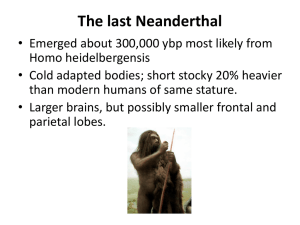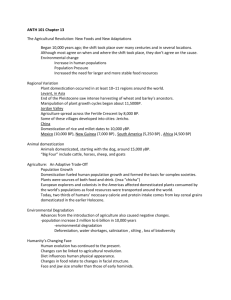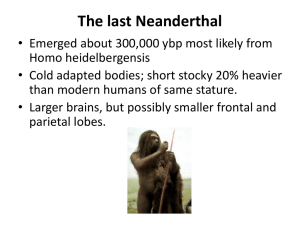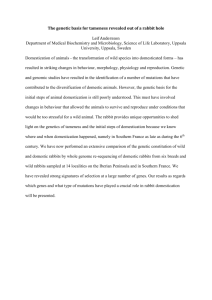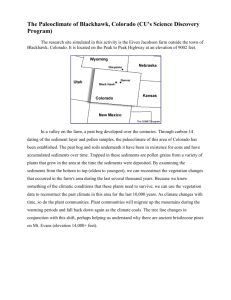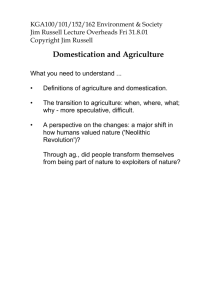Times of Great Change: The Neolithic and the Rise of Civilization
advertisement
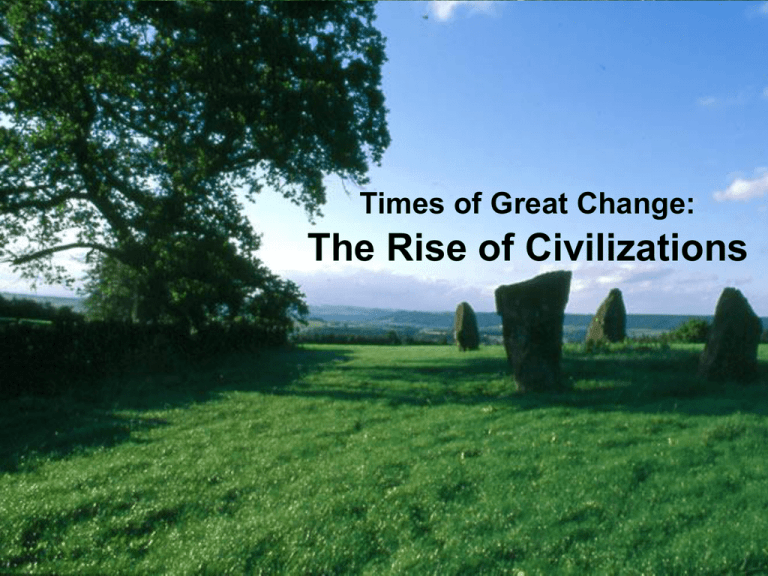
Times of Great Change: The Rise of Civilizations Review 150,000-200,000 years ago: Anatomically Modern Humans move out of Africa to the rest of the world Glaciation lowers sea levels, compress climates Competition between species still going on, but AMH “winning” AMH rapidly developing culturally •70k ybp Symbolism with incised ochre •65k ybp Microliths •60k ybp Sea travel •50k ybp Definite structures •40k ybp Grave goods, cremation, hafted tools •35k ybp Mobilary (transportable) art •32k ybp Cave Art •30k ybp Grindstones indicate plant processing •26k ybp First ceramics •20k ybp First heat treatment of chert Microliths Approximate times of AMH migrations Upper Paleolithic Cultural “Surge” Mobilary Art Individual Identity Wide Range of Tools Cave Art •Incorporates surface and texture of rock •Development of perspective •Different phases of development •Reasons: •Hunting magic •Hunting training •Totemic symbols •Binary oppositions reflecting society •Shamanic mental images Mesolithic 12,000-8,000 years ago The end of the Paleolithic: •cultural florescence •wide range of artistic achievement •specialized hunting pattern •well adapted to the Pleistocene glaciation. Almost hypertrophic, that is, overdeveloped. Eases off around 12,000 years ago. Between 12,000-8,000 in the Old World we know little of human cultural change. In the New World we know more •a continuation of the pattern of hunting with groups adjusting to the changes in climate and the availability of animal life. A slight transformation from nomadic life to settled life. Into the Americas Pleistocene Extinctions 50,000 years ago: Worldwide die-off of the Pleistocene megafauna At least 200 genera: •Large herbivores (mammoths, mastodons, huge ground sloths, cave bears, woolly rhinoceros, other rhinoceroses, etc.) •Carnivores that fed on them, the dire wolves and sabre-tooth cats. There was no accelerated extinction of smaller terrestrial species, plants, or marine organisms. The following disappeared from America, Europe and Australia: •All herbivores> 1000 kg •75% of herbivores100-1000 kg •41% of hervibores5-100 kg •< 2% of hervibores< 5kg See Whitney-Smith’s Dissertation on the subject Overkill? In the Americas, •Hypothesis that human hunting was part of disappearance •“Pleistocene overkill” Very controversial Likely involves more that human hunting, including the dramatic climatic changes going on as glaciers melted. The adjustment to the end of glaciation was no small matter: landforms changed, climate changed and the distribution of plants and animals changed. So too did the level of population and their distribution. Incipient cultures: A warning about the notion of "progress" China, Amazon, Mexico and especially SW Asia began culture changes that would eventually • In some of these areas, cultures would follow courses toward urban life •Incipient means developing, and in some ways this is an unfortunate choice of words. •A linear idea that cultures progress •A holdover to unilinear evolution: savages to barbarian to civilized Try this instead: Cultures adjust to their natural and cultural environments as they need. Other cultures changed, but did follow a path toward large populations, urbanization and large scale civilizations. Cultivars: The Natufian in Palestine and Khartoum in Egypt/Sudan had prototypes of the earliest domesticated plants and animals in more or less wild states. Flannery suggests that in such areas, climatic change stimulated a concentration on particular species. People gradually shifted their attention to the use of particular plants and modified them. Cultivars are wild plants, but with some level of selection by humans who use them. Sumpweed They are not domesticated, in that they do not depend on humans for survival and propagation. That is, they are not cultigens. Happened in many areas-Marsh elder or iva, also know as sumpweed Trying to preserve old ways of gathering, actually led to a new economic food pattern. Also see adaptations of old technologies into new tools •Microliths using insertion technique used in sickles for cutting seed-bearing plants. The Neolithic and Domestication of Plants and Animals A time of dramatic change The beginnings of settled life based on animal and plant domestications Earliest dates for food production are known from the Near East: 12,000 to 6000 years ago (10,000-4000 BC). Wheat, barley, sheep and goats, and cattle. The real questions are how, when, and why did domestication happen? A simple, but accurate view Robert Braidwood’s nuclear zones Regions with a natural environment that included a variety of wild plants and animals, both possible and ready for domestication. Tigris/Euphrates, Nile, Indus, China, Mesoamerica, Central Andes Not a very useful model: •Doesn't tell us why people began to focus on particular species or •Doesn’t give us mechanisms to explain it. Adaptation is always a local problem. Selective pressures favor new forms that result from imbalances in the system. In other words, there have to be reasons for change. In terms of domesticates, what are the selective pressures? • Reliability of the food source. • Production in adequate quantities to meet population needs. • Nutritional requirements must be met in terms of calories, vitamins, minerals. • Does the food store easily? Einkorn Population pressure model (Binford) Ties back to populations tending to locate on coasts during the Mesolithic. Environmentally rich areas Populations eventually become to large for the coastal zones to handle There is pressure to move the excess into increasingly marginal zones Must focus on more marginal species such as the weeds and grasses that eventually become cereal grains Seems to hold in several areas of SW Asia and Central America, but not in others The Economy of Cities: Jane Jacobs Animals domesticated by keeping captured wild animals in storage "on the hoof" in corrals. Selection for docility. Wild plant seeds are gathered in copious quantities and stored in granaries. Earliest cities like Çatal Hüyük or Jericho do have granaries before domesticates appear. Granaries cleaned at the end of the year Old seeds are thrown out and sprout just outside the granaries People recognize they can plant these seeds, saving the best seeds for just this growth, thereby Selection for the largest and best producers. Co-evolution: David Rindos Humans are drawn, intentionally or otherwise, into long term relations with plants and animals and the general environment. Humans become dispersal agents for plants, protecting certain taxa - eventually causing morphological changes in some of them. The human impact on the environment creates "anthropogenic locales". Sedentism and Social Hypothesis: Barbara Bender How you organize societies has a big effect on productivity. Alliances and exchange When there is a communication-exchange network there is someone controlling activity and creating surpluses. She argues that it is not until this kind of society occurs that you see domestication. All can be fit into Braidwood’s nuclear zones •Each nuclear zone is similar, but with local adaptations. •Which comes first, urbanization or domestication? •How is urbanization defined? •If large populations living in an aggregated settlement, then that may have happened in many areas before domestication. •Joseph Caldwell defined Primary Forest Efficiency with groups having populations of 1000 or more in a settlement without agriculture. •Rich natural environment particularly made it possible Control of key resources In areas of the Middle East, control of certain resources such as obsidian, lapis lazuli, bitumen and accompanying trade allowed large populations to grow. Beyond a certain level required abundant and relatively reliable food resources to support the population Obsidian Lapis lazuli Bitumen with reed impressions How to Grow? Irrigate Increases the environmental carrying capacity. In each nuclear zone wild or near domesticates grew readily but with low yields. In each area, rainfall was insufficient for planting large quantities of cultigens. In some areas (Nile, China, Indus, T/E) annual floods provided adequate moisture, but only if modified. Use of the floodwater was variable from place to place and required a complete readjustment of subsistence, settlement, and social organization. What does domestication allow? Greater population Surpluses What do more bodies and surpluses allow? Specialization of labor Social Stratification Social control More rapid change Centers of Early Civilization Indus River China River Valleys Central Mexico Andes Mountains Nile River Valley Mesopotamia (Tigris & Euphrates Rivers) Each area is linked to an extraordinary web site about the ancient civilization of the region The Markers of Civilization Urban Life Mohenjo-daro Harappa Monumental Architecture And along with that… Writing SW Asia Cunieform writing Mathematics Peruvian Quipu (both math and writing) Mayan Complex religious rituals Astronomy Exotic trade goods & lots of other “stuff” Fine Arts China Mesopotamia Conquest and Empire The State The Multiplier Effect The greater the population, the faster the rate of change. The greater the existing variety, the faster the rate of change. The greater the environmental instability, the faster the rate of change. The greater the amount of intercultural contact, the faster the rate of change. Still, it took 3000 years to accomplish this readaptation before the first urban centers actually develop In other words, change can happen rapidly. Is there a limit? Apparently.
